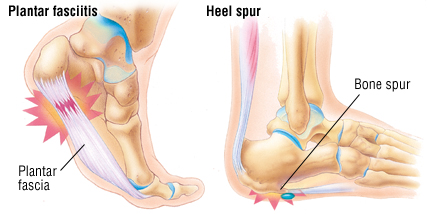Pain on the bottom of the heel is most often caused by plantar fasciitis, a condition that is sometimes also called heel spur syndrome when a spur is present. Heel pain may also be due to other causes, such as a stress fracture, tendonitis, arthritis, nerve irritation, or, rarely, a cyst. Because there are several potential causes, it is important to have heel pain properly diagnosed.
What Is Plantar Fasciitis?

Plantar fasciitis is an inflammation of the band of tissue (the plantar fascia) that extends from the heel to the toes. In this condition, the fascia first becomes irritated and then inflamed-resulting in heel pain. The symptoms of Plantar Fasciitis are:
- Pain on the bottom of the heel.
- Pain that is usually worse upon arising.
- Pain that increases over a period of months.
People with plantar fasciitis often describe the pain as worse when they get up in the morning or after they’ve been sitting for long periods of time. After a few minutes of walking the pain decreases, because walking stretches the fascia. For some people, the pain subsides but returns after spending long periods of time on their feet.
Causes of Plantar Fasciitis
The most common cause of plantar fasciitis relates to the faulty structure of the foot. For example, people who have problems with their arches–either overly flat feet or high-arched feet–are more prone to developing plantar fasciitis. Tightness in the Achilles’ tendon and calf muscles are also major contributing factors.
Wearing non-supportive footwear on hard, flat surfaces puts an abnormal amount of strain on the plantar fascia and can lead to plantar fasciitis. This is particularly evident when peoples’ jobs require long hours on their feet. Obesity also contributes to plantar fasciitis.
Diagnosis
To arrive at a diagnosis, the doctor will obtain your medical history and examine your foot. Throughout this process, he rules out all the possible causes for your heel pain other than plantar fasciitis.
In addition, diagnostic imaging studies such as x-rays and diagnostic ultrasound may be used to distinguish the different types of heel pain. Sometimes heel spurs are found in patients with plantar fasciitis. Heel spurs rarely cause pain. It is important to remember that heel spurs are a result of plantar fasciitis and its associated pain, not the cause of the pain. When they are present, the condition may be diagnosed as plantar fasciitis/heel spur syndrome.
